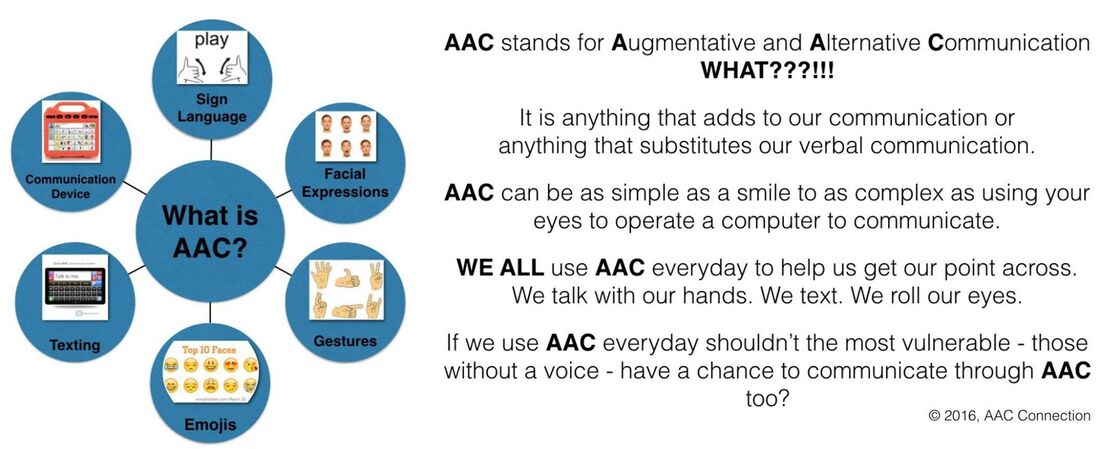 Image source: AAC Connection Image source: AAC Connection In honor of October being AAC awareness month, I would like to introduce you to AAC and share how you can be a respectful communication partner. AAC stands for augmentative and alternative communication. You may have seen someone write in a notebook to answer a question. Maybe you have seen people using sign language or other gestures. You may have seen someone push buttons on a computer that speaks for them. These are all forms of augmentative and alternative communication, or AAC. AAC includes all of the ways we share our ideas and feelings without talking. It is an umbrella term that encompasses the communication methods used to supplement or replace speech or writing for those with impairments in the production or comprehension of spoken or written language. The goal of AAC is to achieve the most effective communication possible for the individual in order to maximize their potential and lead the highest quality of life possible. There are many types of AAC from alphabet boards to iPads with specialized apps to Dynavoxes or specialized computers. The Picture Exchange Communication System, or PECS, allows people with little or no communication abilities to communicate using pictures. People using PECS are taught to approach another person and give them a picture of a desired item in exchange for that item. I am able to speak but it is often difficult for outsiders to understand me, you need to focus on what I am saying and not be distracted. I can not speak clearly or fast enough for strangers to understand and be patient. When I have a lot to say it can become jumbled and you may only get bits of pieces and a lot lost in translation. My parents, siblings and close friends are able to understand me especially in one to one quieter settings. I use my iPad to communicate with others. People make assumptions that I can not speak and or understand. If I only communicated through text people would not know I had a disability. People, including doctors, are impressed with my writing ability and it changes their view of me. Be patient. Talk to me. Listen to me. These are key messages for good communication partners. Consider 10 strategies to put the AAC user first in your conversations.
For me, personally, if it is quiet I prefer to try using my voice first especially if the person I am talking to is patient or familiar with me, as typing takes a lot out of me and a really long time. However, sometimes words just get stuck and it’s just easier to use my iPad. Everyone has their own unique voice, experiences and desire to connect and be included, no matter their communication style. It is always important to ask the individual their own personal preferences, be patient and understanding, speak to the individual as an equal and a person, not hover over the individual, not touch the person’s device unless the person says it’s okay and always always put the person first! You can also learn more about the 10 strategies to be a respectful communication partner as well as access a checklist to see if you are a good communication partner here: www.assistiveware.com/learn-aac/follow-their-lead-how-to-be-a-respectful-communication-partner?fbclid=IwAR0Thh3hi0lD0NSwXG--J6xdYLdX9hYA9y-utORq5mYK5V27uxNxBt5RuWI
4 Comments
|
AuthorWrite something about yourself. No need to be fancy, just an overview. Archives
August 2022
Categories |
 RSS Feed
RSS Feed
